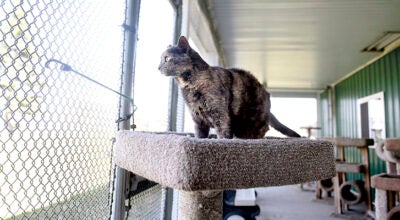State agencies not sold on new chronic wasting disease test option
Published 5:57 pm Friday, March 17, 2023
|
Getting your Trinity Audio player ready...
|
By Dan Gunderson
Research at the University of Minnesota led to the recent launch of a company marketing a new test for chronic wasting disease in cervids, like deer and elk.
University of Minnesota researchers didn’t create the RT-QuIC test, but they used the technology to develop a less invasive CWD test using muscle tissue or skin.
Pronounced ‘R-T-quick’, the test makes testing of live animals possible.
Current testing using federally-approved tests can be done only if animals die or are killed, and lymph nodes or brain matter is removed for testing to verify the disease. That means captive deer often aren’t tested until they die or show symptoms of the disease, and that’s often too late to stop the spread of the disease.
“We are consistently two to three years behind this disease. The traditional tests are two to three years behind,” contends Peter Larsen, the co-director of the Minnesota Center for Prion Research and Outreach at the University of Minnesota, and CEO of Priogen, the startup company selling CWD tests.
“Being able to produce rapid real time results that are accurate, that is a critical component to managing this disease,” he said. “And that’s what we’re able to do.”
Big hurdle
Live animal testing could help prevent the spread of CWD by testing farmed white-tailed deer herds, said Larsen, who plans to offer a test using a small tissue sample taken from a deer’s ear.
He’s also pitching a muscle based CWD test as an option for hunters who want assurance meat from a wild deer they plan to eat isn’t infected.
Larsen points to dozens of studies that show the RT-QuIC test is accurate.
But the test has not been validated by the federal government, and Larsen knows that creates a big hurdle.
“Will the Board of Animal Health or will the DNR honor an RT-QuIC positive or will they say, it’s not a test that they’re using,” Larsen said.
“The Board of Animal Health still has many concerns about using a test that is not validated by our USDA partners,” said Minnesota Board of Animal Health senior veterinarian Courtney Wheeler.
Because disease surveillance of farmed deer is a national program, Wheeler said there could be financial ramifications if the agency used a test not validated by the U.S. Department of Agriculture.
Minnesota DNR Wildlife Health Group Leader Michelle Carstensen recommends hunters not use the RT-QuIC testing option.
“We would not consider that to be a valid result,” she said. “So that is a challenge because a hunter may choose to purchase one of these tests and get a result that suggests their deer is positive.”
The DNR would require a confirmatory test before taking any action. And unless the hunter saved the deer head or lymph nodes, such a test would not be possible.
Regulatory lag
The DNR is not currently under the same federal constraints as the Board of Animal Health to use only a USDA validated test, according to Carstensen, but she said the technology is well ahead of the regulatory process.
“There isn’t a state in the union right now that recognizes RT-QuIC as a valid test and utilizes it in their testing programs for farmed or wild cervids,” said Carstensen. And that’s because we want to communicate with each other in the same language, which is a confirmed, validated test.”
The RT-QuIC live animal test has great potential for surveillance of farmed deer herds, said Carstensen, but it would only be feasible as a voluntary, not mandatory, test option for farmers until the test is validated by the USDA.
State Representative Jamie Becker-Finn is author of a bill to mandate RT-QuIC live animal testing on farmed deer in Minnesota.
“For years we were told, ‘well, if we had a live test, if we had a live test, if we had a live test’, well, now we have a live test and there doesn’t seem to be the urgency to get it validated so that it can be a tool that’s used,” said Becker-Finn.
The U.S. Department of Agriculture has began the process of validating the RT-QuIC test, but it could be years before the muscle or skin tests for CWD are approved by the government. Becker-Finn says the state should not wait.
“We’re just at a point where we need to do something and the peer reviewed research that I’m reading says that this is a test that we absolutely should be looking into using more,” she said. “The status quo is clearly not working.”
Peter Larsen says he expects debate about using the new test will continue.
“There is going to be this phase where decisions are going to have to be made,” he said. “When a test is accurate, is sensitive, can be used in new ways — how are folks going to use that for management and surveillance?”
It’s unclear if lawmakers and state agencies will agree on the answer.
Becker-Finn sees support in the legislature to change the response to chronic wasting disease.
“This has been a difficult issue for years and it will continue to be,” she said. “But I do think we’re poised to hopefully actually do something substantive this year.”




